These healthy, gluten-free flatbreads known as Bajra Roti (or Bajre ki Roti or Bajra Bhakri) are a delicious pairing for any Indian lentil or vegetable-based curry. My recipe is very easy to make, requiring just 20 minutes of prep time. Try making these tasty, hearty roti today!
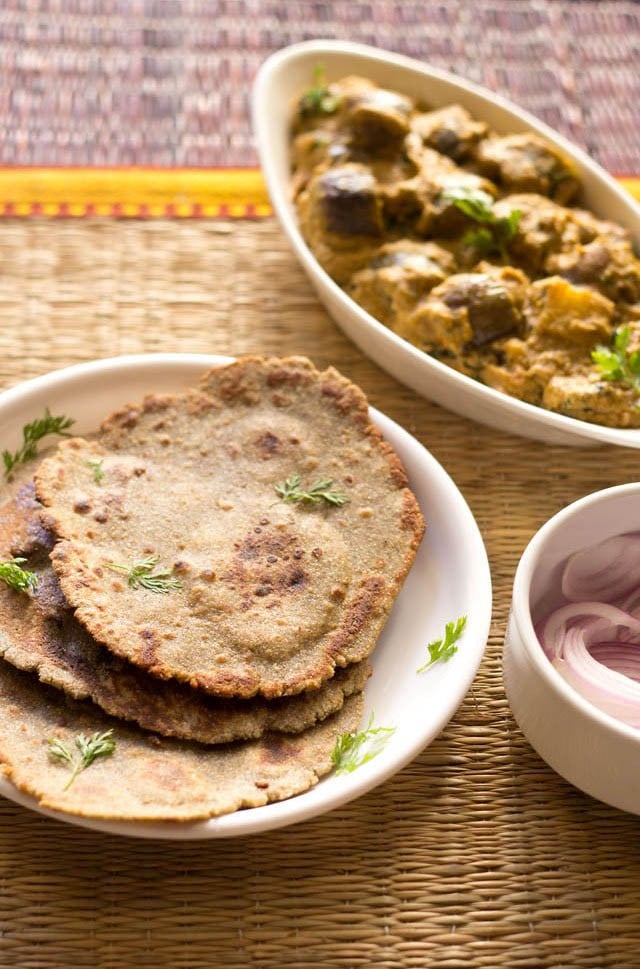
About Bajra Roti
Bajra roti (also known as bajra bhakri) is a gluten-free flatbread made with pearl millet flour. Bajra is the Hindi word for pearl millet. These gluten-free flatbreads are an excellent nutritious option for anyone with a gluten sensitivity, and for everyone else, too!
There are many types of grains to choose from when making Roti, so I do my best to try them all. Some days I make multigrain flour rotis by mixing together different flours, other times I stick to just a single grain like for these bajra roti or my Jowar Roti (sorghum flour flatbread).
You should also know that pearl millet (bajra) isn’t the only kind of millet flour around. I also like to make Ragi Roti (from finger millet flour). Millets are healthy grains, so you should try to include them in your diet.
These tasty bajre ki roti are a delightful way to introduce millet into your diet. Not only are they hearty, tasty, and easy to make, they’re also quite healthy! In fact, bajra roti has been associated with improved gut health, weight loss, and stabilized blood sugar.
This simple bajre ki roti recipe requires just 4 ingredients, meaning a tasty, gluten-free flatbread is never far from reach. All you need is pearl millet flour, a neutral-flavored oil, salt, and water, plus a little under an hour to make them. Easy, right? So let’s get started.
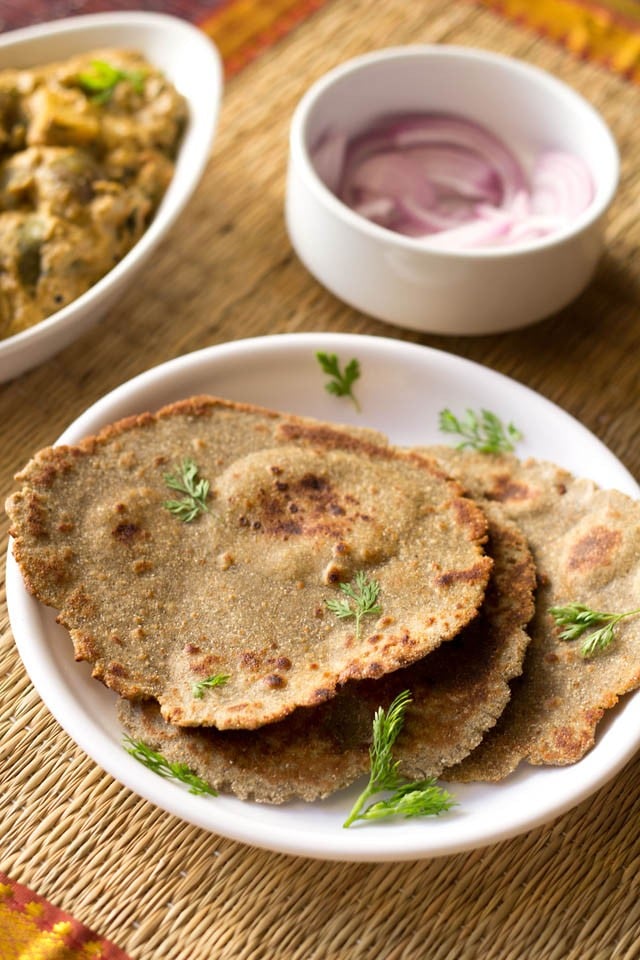
Step-by-Step Guide
How to Make Bajra Roti
1: First, heat 1 cup of water. The water should be hot but not boiling. Switch off the heat, then add the oil and salt. Mix well.
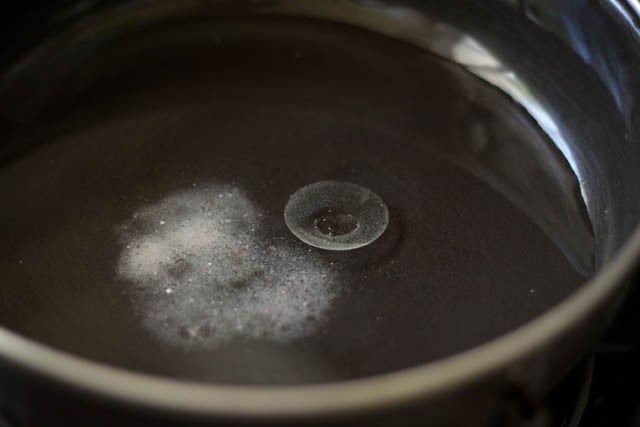
2: Add 2 to 2.5 cups of bajra flour to the water (or vice versa).
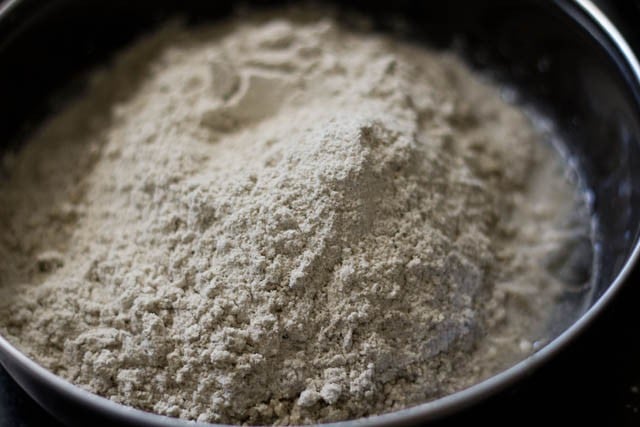
3: Mix with a spoon if the water is too hot. If you use warm water, then you can use your hands for mixing.
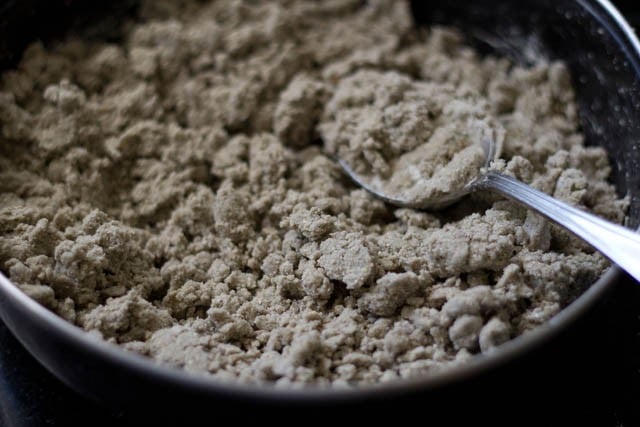
4: Gather the mixed dough and knead to a smooth dough.
Tip 1: If the dough looks dry and crumbly, add some hot water. Mix and knead.
Tip 2: If the dough looks too moist or wet or has become sticky, add some bajra flour. Mix and continue to knead.
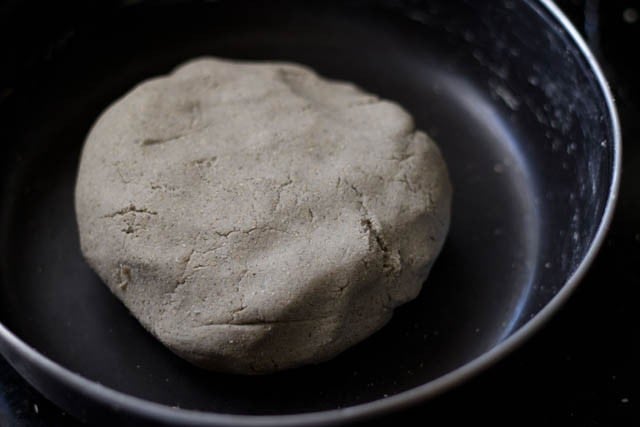
5: Pinch a small or medium-sized ball, flatten it slightly with your palms, and dust it with some bajra flour.
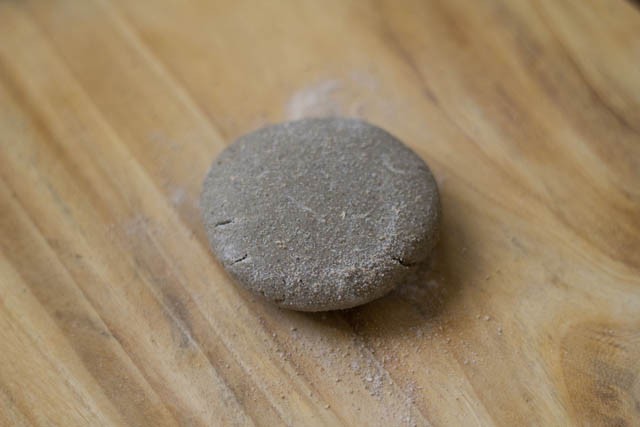
6: Using your palms, flatten the dough. This is not my forte, so I like to fold a ziplock bag, place the dough ball between the halves, and gently roll it out with a rolling pin or by using my hands to press it outwards.
Dust lightly with flour as needed to keep the dough from sticking.
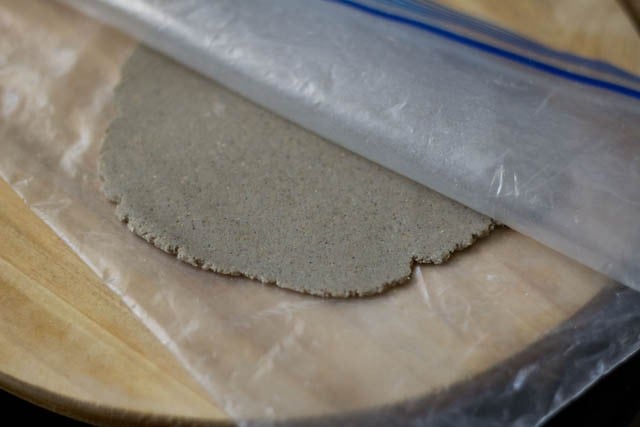
7: Gently remove the flat uncooked bread from the ziplock bag and place it on a hot tawa or flat pan or skillet. Keep the heat from medium-high to high.
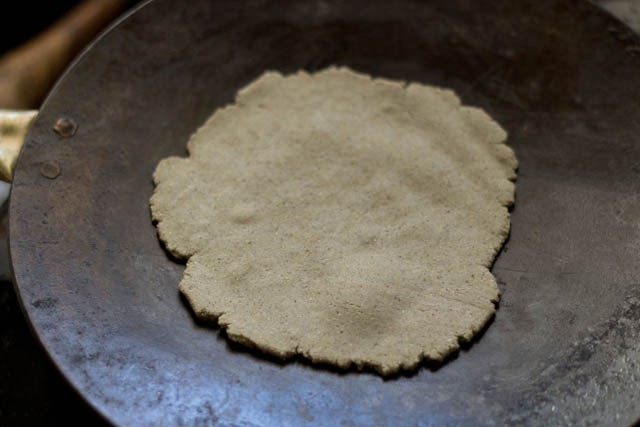
8: Cook the first side until you see a few blisters. Flip and cook the other side. Flip a couple of times and cook till brown spots and blisters appear on both sides.
Spread some oil or ghee on top. Stack all the roti in a roti basket or casserole.
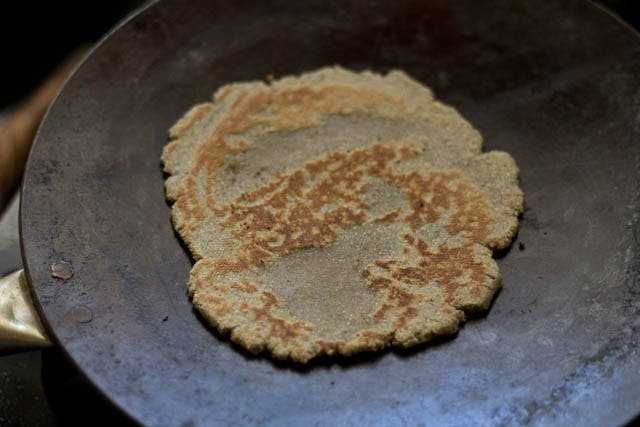
9: Serve Bajra roti hot or warm with an Indian vegetable curry, dal or side veggie dish. Enjoy!
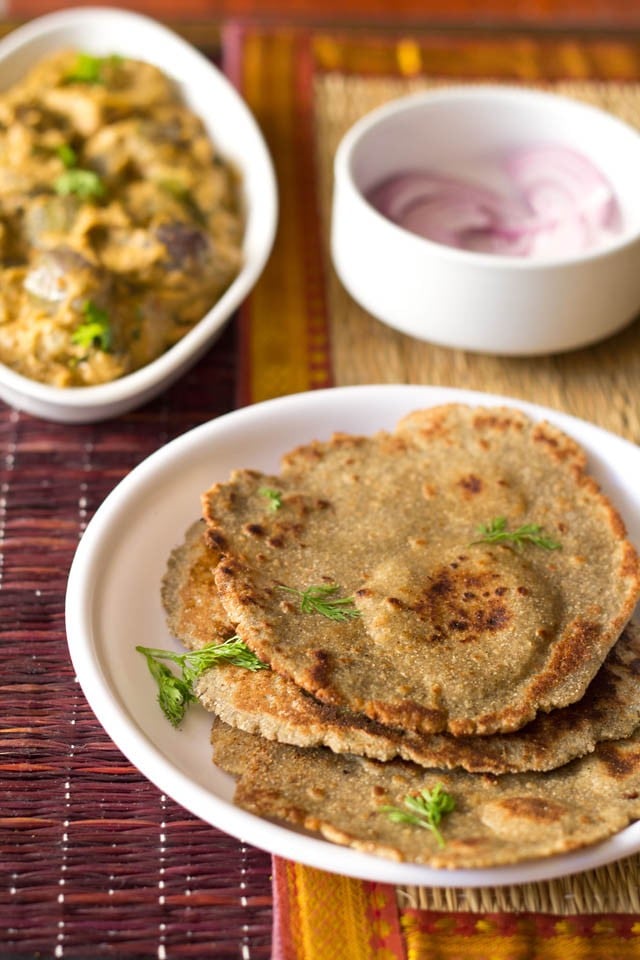
Expert Tips
Making bajra bhakri isn’t necessarily difficult, but it does take a bit of practice and finesse. Here are some of my best tips for ensuring your roti come out perfectly every single time:
- Be sure to use hot water. The dough becomes more pliable and easier to roll if you use hot water. The rotis will also have a softer texture if you do. Note that the water needn’t be boiling hot – just hot enough like that while taking a shower or doing the dishes.
- Variation: If you find making these flatbreads too cumbersome, add some whole wheat flour (atta). Including whole wheat flour in the dough will make it easier for you to roll the roti.
- Don’t use only a rolling pin. Because these rotis are gluten-free, the dough is rather delicate. Rather than trying to roll out the dough as you would for wheat roti, I suggest using a ziplock bag as a non-stick surface on either side of the dough balls and using your hands to press the dough into a circle or gently rolling it out with a rolling pin.
- Use an oil with a high smoke point. Ghee, vegetable oil, avocado oil, sunflower oil or peanut oil will all work. Oils with a lower smoke point like olive oil should be avoided.
- Serve the bajra roti warm alongside a vegetable curry, dal, or even a side dish. I served the Bajra roti with Bharli Vangi (stuffed aubergines in peanut-coconut-sesame gravy) this time around, and the combo was really good.
They would also taste great with a good North Indian, Maharashtrian or Gujarati vegetable or legumes curry like Usal, Gutti Vankaya Kura, Sprouts Curry, or my Ennegayi recipe.
FAQs
You sure can! If the dough becomes wet in the fridge, simply add a tablespoon or two of bajra flour; if it is too dry, add a tablespoon or two of water. Be sure to use within 24 hours for best results.
I’d suggest around the temperature that you’d want for taking a shower. Hot, but not scalding!
Using a rolling pin isn’t advised for making bajra roti because the dough is very delicate. Without the addition of wheat flour (atta), no gluten is created. While that is good news for celiacs, it is not great for those of you who are used to using a rolling pin.
To simplify the process, I suggest using a ziplock bag, two sheets of parchment, or even a large muslin cloth to enclose the dough, then use your hands to press it out into a round flatbread shape.
If you are still having difficulty, try adding a bit of potato flour/potato starch or whole wheat flour (atta) to the dough to help make it a bit more pliable.
More Roti Recipes To Try!
Indian Breads
Indian Breads
Indian Breads
Indian Breads
Please be sure to rate the recipe in the recipe card or leave a comment below if you have made it. For more vegetarian inspirations, Sign Up for my emails or follow me on Instagram, Youtube, Facebook, Pinterest or Twitter.
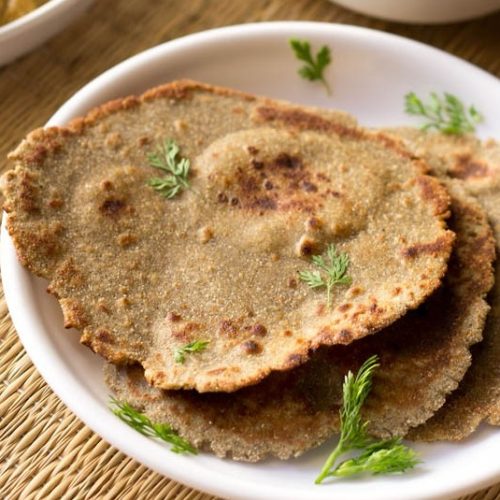
Bajra Roti | Bajre ki Roti (Pearl Millet Flatbread)
Bajra Roti also known as Bajre ki Roti or Bajra Bhakri are gluten-free flatbreads made from pearl millet flour (a.k.a bajra flour). These healthy flatbreads pair deliciously with any Indian lentil or vegetable-based curry.
Prep Time 20 mins
Cook Time 30 mins
Total Time 50 mins
Prevent your screen from going dark while making the recipe
Kneading dough
Heat or warm the water. Add salt and oil. Stir to mix.
Add the bajra flour. Stir with a spoon first. When the heat is fine to handle, knead into a smooth and soft dough.
If the dough becomes sticky, then add more flour.
If the dough is crumbly or dry, then add some water.
Making bajra roti
Meanwhile heat a tawa or a flat fry pan or skillet.
Make medium sized balls from the dough. Dust lightly with flour on both sides. Use parchment sheets or ziplock bag for rolling.
Place the dough ball between two parchment sheets or inside a ziplock bag.
Roll gently to a flat round shape.
Remove gently from the ziplock bag and place the rolled roti on the hot tawa or skillet.
Cook till both sides have brown spots and done on a medium-high to high heat.
- When one side is partly cooked, flip and cook the second side. Flip a few times for even roasting of the roti. You should see brown spots or blisters on both sides. Take care not to burn the roti.
When roasted well enough, remove and spread a bit of oil or ghee on one side.
Make bajre ki roti this way in batches and stack them up in a roti basket.
You can also opt to pan fry the bajra roti like paratha with oil or ghee directly in the tawa/frying pan.
Serve Bajre ki Roti hot or warm with a vegetable side dish or curry.
- Knead dough in hot water: Try to knead the dough in hot water. The dough becomes pliable and easy to roll when using hot water and the rotis have a soft texture too. You can also opt to knead the dough in warm water. Note that the water needn’t be boiling hot – but just hot enough like that when rinsing the dishes.
- Rolling Tips: Bajre ki roti is gluten-free, thus the dough is delicate. The dough can be patted with fingers if you have the practice of it. Or roll using a ziplock bag or parchment paper on either side of the dough ball, using your hands to press the dough into a circle or gently rolling it out with a rolling pin.
- Fats: You could leave out the fats if you prefer. If you want to use them, then use an oil with a high smoke point. Ghee, sunflower oil, vegetable oil, avocado oil, or peanut oil will all work. Oils with a lower smoke point should be avoided.
Nutrition Facts
Bajra Roti | Bajre ki Roti (Pearl Millet Flatbread)
Amount Per Serving
Calories 249 Calories from Fat 63
% Daily Value*
Fat 7g11%
Saturated Fat 1g6%
Polyunsaturated Fat 2g
Monounsaturated Fat 4g
Sodium 153mg7%
Potassium 182mg5%
Carbohydrates 40g13%
Protein 7g14%
Vitamin B1 (Thiamine) 0.2mg13%
Vitamin B2 (Riboflavin) 0.2mg12%
Vitamin B3 (Niacin) 1mg5%
Vitamin E 2mg13%
Vitamin K 0.2µg0%
Calcium 26mg3%
Vitamin B9 (Folate) 27µg7%
Iron 5mg28%
Magnesium 81mg20%
Phosphorus 175mg18%
Zinc 2mg13%
* Percent Daily Values are based on a 2000 calorie diet.
This Bajre ki Roti recipe from the archives first published in March 2013 has been republished and updated on November 2022.
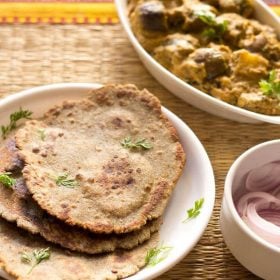
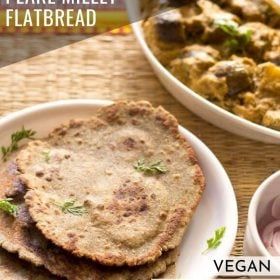
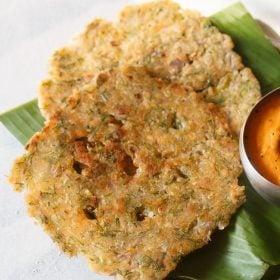
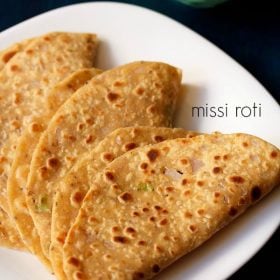
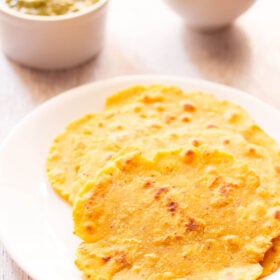
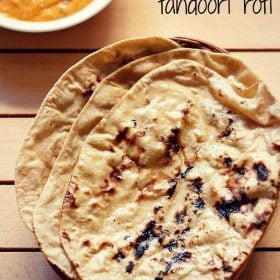









0 Comments